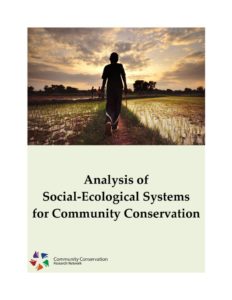Introduction
Social-ecological systems (SES) are complex integrated systems that consist of two interacting subsystems, human (social) and ecological (biophysical). Understanding the mechanics behind SES is essential to understanding how a community associates with conservation. This understanding can be used to help design conservation policies and practices that will be sustainable and beneficial to a community.
This guidebook was designed to educate individuals on the key concepts, definitions and ideas involved in SES analysis and how these ideas can be applied to real world case studies. For a brief introduction to SES browse the tabs to the right where we discuss:
- Key concepts of SES
- Frameworks and attributes that you can use to analyse SES
- Definitions for the terms often used in SES literature
- Case studies where SES is used to analyse community conservation
- Supplementary material
This on-line version of our guidebook is condensed from the full version. To immediately access the latter, as a PDF file, please click on the image above.
 NEXT: Concepts
NEXT: Concepts



